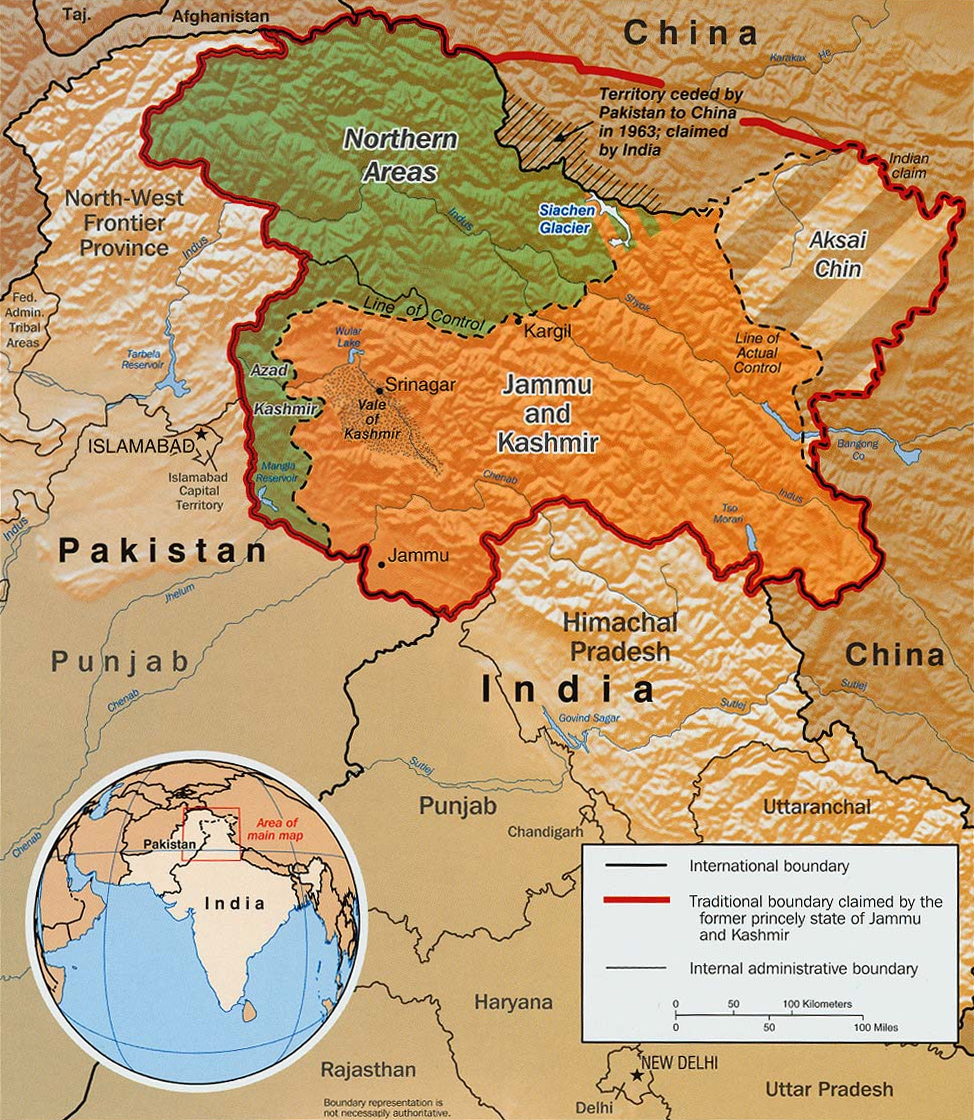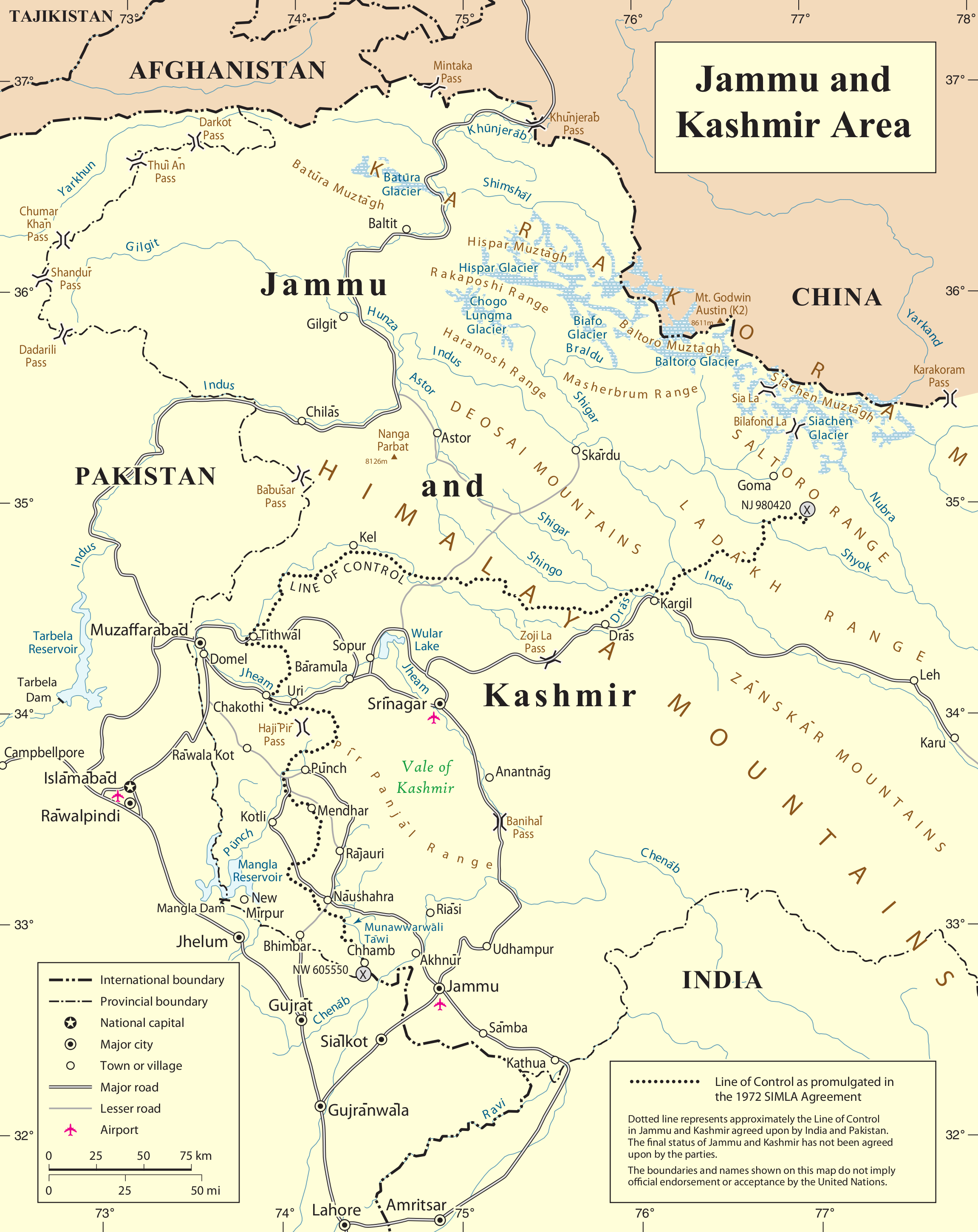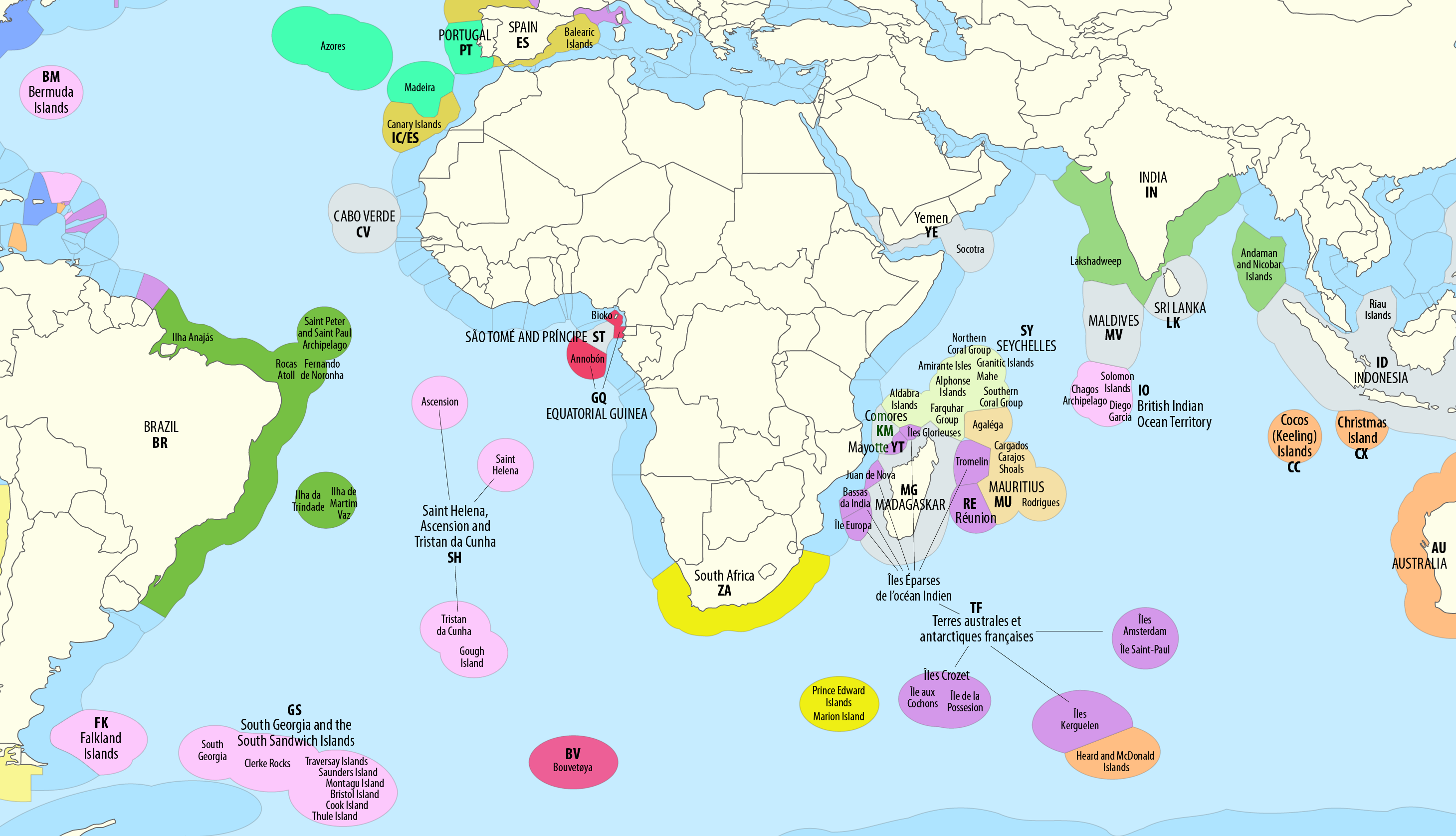|
Gyong La
Gyong La is a mountain pass situated on Saltoro Ridge southwest of the vast Siachen Glacier, some directly north of map point NJ9842 which defined the end of the 1972 Line of Control between India and Pakistan. With Pakistan controlling areas just to the west along Chumik Glacier, the immediate Gyong La area has been under India's control since 1989. Dozens of Indian military tents and other equipment are visible in 2013 and 2016 Google Earth imagery 100 meters east, 670 meters northeast, and 2.7 km east-northeast of Gyong La, linked by clear trails. Nearer the former Pakistani "Naveed Top" position and 3.85 km west-northwest of Gyong La is a post and helipad is visible in 2001 and 2016 Google Earth imagery at elevation, higher than both the Indian positions and Gyong La. Background Indo-Pak conflicts Starting in 1984 during Operation Meghdoot, the first military action of the Siachen Conflict, which itself was part of a larger Kashmir Conflict, there was mi ... [...More Info...] [...Related Items...] OR: [Wikipedia] [Google] [Baidu] |
Chumik Glacier
Chumik Glacier is located in the Siachen region. Located on the west of Saltoro ridge, it is a 4-mile-long offshoot of the Bilafond Glacier. History In military terminology, Chumik is a minor sub sector of Bilafond Sub Sector,Chumik ops near Gyong La. In March 1989, launched the Operation Ibex to seize the Pakistani post overlooking the Chumik Glacier. The operation was unsuccessful at dislodging Pakistani troops from their positions. The Indian Army under Brig. R. K. ... [...More Info...] [...Related Items...] OR: [Wikipedia] [Google] [Baidu] |
Ladakh
Ladakh () is a region administered by India as a union territory which constitutes a part of the larger Kashmir region and has been the subject of dispute between India, Pakistan, and China since 1947. (subscription required) Quote: "Jammu and Kashmir, state of India, located in the northern part of the Indian subcontinent in the vicinity of the Karakoram and westernmost Himalayan mountain ranges. From 1947 to 2019, Ladakh was part of the Indian state of Jammu and Kashmir, which has been the subject of dispute between India, Pakistan, and China since the partition of the subcontinent in 1947." Quote: "Jammu and Kashmir: Territory in northwestern India, subject to a dispute between India and Pakistan. It has borders with Pakistan and China." Ladakh is bordered by the Tibet Autonomous Region to the east, the Indian state of Himachal Pradesh to the south, both the Indian-administered union territory of Jammu and Kashmir and the Pakistan-administered Gilgit-Baltistan to the wes ... [...More Info...] [...Related Items...] OR: [Wikipedia] [Google] [Baidu] |
Saltoro Mountains
The Saltoro Mountains are a subrange of the Karakoram Range. They are located in the southeast Karakoram on the southwest side of the Siachen Glacier, one of the two longest glaciers outside the polar regions. The name given to this range is shared with the Saltoro Valley which is located to the west of this range, downslope on the Pakistan side of the Saltoro Range which generally follows the Actual Ground Position Line. Saltoro Kangri peak, Saltoro River, and Saltoro Valley are features on this range. The Actual Ground Position Line (AGPL) between Indian and Pakistan held area runs through this range, where the high peaks and passes of the Siachen area are held by Pakistan,the peaks and valleys to the west after successfully taking back control from India in 1999 Kargil war. The Saltoro Mountains are ''Lesser Karakorams'' on the southwestern side of the large Karakoram-glaciers ( Siachen, Baltoro, Biafo and Hispar Glacier from east to west) while the main ridge of the K ... [...More Info...] [...Related Items...] OR: [Wikipedia] [Google] [Baidu] |
Siachen Conflict
The Siachen conflict, sometimes referred to as the Siachen Glacier conflict or the Siachen War, was a military conflict between India and Pakistan over the disputed Siachen Glacier region in Kashmir. The conflict was started in 1984 by India's successful capture of the Siachen Glacier as part of Operation Meghdoot, and continued with Operation Rajiv in 1987. India took control of the Siachen Glacier and its tributary glaciers, as well as all the main passes and heights of the Saltoro Ridge immediately west of the glacier, including Sia La, Bilafond La, and Gyong La. Pakistan controls the glacial valleys immediately west of the Saltoro Ridge. A cease-fire went into effect in 2003, but both sides maintain a heavy military presence in the area. The conflict has resulted in thousands of deaths, mostly due to natural hazards. External commentators of have characterized it as pointless, given the perceived uselessness of the territory, and indicative of bitter stubbornness on ... [...More Info...] [...Related Items...] OR: [Wikipedia] [Google] [Baidu] |
Kashmir Conflict
The Kashmir conflict is a territorial conflict over the Kashmir region, primarily between India and Pakistan, with China playing a third-party role. The conflict started after the partition of India in 1947 as both India and Pakistan claimed the entirety of the former princely state of Jammu and Kashmir. It is a dispute over the region that escalated into three wars between India and Pakistan and several other armed skirmishes. India controls approximately 55% of the land area of the region that includes Jammu, the Kashmir Valley, most of Ladakh, the Siachen Glacier, and 70% of its population; Pakistan controls approximately 30% of the land area that includes Azad Kashmir and Gilgit-Baltistan; and China controls the remaining 15% of the land area that includes the Aksai Chin region, the mostly uninhabited Trans-Karakoram Tract, and part of the Demchok sector. After the partition of India and a rebellion in the western districts of the state, Pakistani tribal militias inv ... [...More Info...] [...Related Items...] OR: [Wikipedia] [Google] [Baidu] |
:Category:Borders Of Pakistan
{{Commons category, International borders of Pakistan Pakistan Pakistan ( ur, ), officially the Islamic Republic of Pakistan ( ur, , label=none), is a country in South Asia. It is the world's List of countries and dependencies by population, fifth-most populous country, with a population of almost 24 ... Geography of Pakistan Foreign relations of Pakistan ... [...More Info...] [...Related Items...] OR: [Wikipedia] [Google] [Baidu] |
Borders Of India
The Republic of India shares borders with several sovereign countries; it shares land borders with China, Bhutan, Nepal, Pakistan, Bangladesh and Myanmar. Bangladesh and Pakistan share both land borders as well as maritime borders, while Sri Lanka shares only a maritime border through Adam's Bridge. India's Andaman and Nicobar Islands share a maritime border with Thailand, Myanmar and Indonesia. Land borders of India India shares land borders with seven sovereign nations. The state's Ministry of Home Affairs also recognizes a land border with an eighth nation, Afghanistan, as part of its claim of the Kashmir region (see Durand Line). Maritime borders of India Maritime borders of India are the maritime boundary recognized by the United Nations Convention on the Law of the Sea entails boundaries of territorial waters, contiguous zones, and exclusive economic zones. India, with its claim of a territorial maritime zone and exclusive economic zone, has a more than mari ... [...More Info...] [...Related Items...] OR: [Wikipedia] [Google] [Baidu] |
Borders Of China
China shares international land borders with 14 sovereign states. In addition, there is a internal border with the special administrative region of Hong Kong, which was a British dependency before 1997, and a internal border with Macau, a Portuguese territory until 1999. With land borders of in total, China has the longest aggregate land borders of any country. Countries sharing land borders with China The table below, is a table of countries and territories who share a land border with China around its perimeter. The in parenthesis are their lengths in miles. See also * Territorial changes of the People's Republic of China * Territorial disputes of the People's Republic of China * Chinese–Korean border fence * McMahon Line * Tumen River * Boundaries of Hong Kong * Frontier Closed Area * Sino-Indian border dispute The Sino-Indian border dispute is an ongoing territorial dispute over the sovereignty of two relatively large, and several smaller, separated pie ... [...More Info...] [...Related Items...] OR: [Wikipedia] [Google] [Baidu] |
Sir Creek
Sir Creek ( ), originally Ban Ganga, is a 96-km (60-mi) tidal estuary in the uninhabited marshlands of the Indus River Delta on the border between India and Pakistan. The creek flows into the Arabian Sea and separates Gujarat state in India from Sindh province in Pakistan. The long-standing India-Pakistan Sir Creek border dispute stems from the demarcation "from the mouth of Sir Creek to the top of Sir Creek, and from the top of Sir Creek eastward to a point on the line designated on the Western Terminus". From this point onward, the boundary is unambiguously fixed as defined by the Tribunal Award of 1968. Etymology Sir Creek was originally known as Ban Ganga. It was renamed Sir Creek after a representative of the British Raj. [...More Info...] [...Related Items...] OR: [Wikipedia] [Google] [Baidu] |
Line Of Actual Control
The Line of Actual Control (LAC), in the context of the Sino-Indian border dispute, is a notional demarcation lineAnanth KrishnanLine of Actual Control , India-China: the line of actual contest, 13 June 2020: "In contrast, the alignment of the LAC has never been agreed upon, and it is has neither been delineated nor demarcated. There is no official map in the public domain that depicts the LAC. It can best be thought of as an idea, reflecting the territories that are, at present, under the control of each side, pending a resolution of the boundary dispute." that separates Indian-controlled territory from Chinese-controlled territory. The concept was introduced by Chinese premier Zhou Enlai in a 1959 letter to Jawaharlal Nehru as the "line up to which each side exercises actual control", but rejected by Nehru as being incoherent. Subsequently the term came to refer to the line formed after the 1962 Sino-Indian War. The LAC is different from the borders claimed by each ... [...More Info...] [...Related Items...] OR: [Wikipedia] [Google] [Baidu] |
Line Of Control
The Line of Control (LoC) is a military control line between the Indian and Pakistanicontrolled parts of the former princely state of Jammu and Kashmir—a line which does not constitute a legally recognized international boundary, but serves as the de facto border. It was established as part of the Simla Agreement at the end of the Indo-Pakistani War of 1971. Both nations agreed to rename the ceasefire line as the "Line of Control" and pledged to respect it without prejudice to their respective positions. Apart from minor details, the line is roughly the same as the original 1949 cease-fire line. The part of the former princely state under Indian control is divided into the union territories of Jammu and Kashmir and Ladakh. The Pakistani-controlled section is divided into Azad Kashmir and Gilgit–Baltistan. The northernmost point of the Line of Control is known as NJ9842, beyond which lies the Siachen Glacier, which became a bone of contention in 1984. To the south ... [...More Info...] [...Related Items...] OR: [Wikipedia] [Google] [Baidu] |
India–Pakistan Border
The Indo–Pak border or India-Pakistan border is the international boundary that separates India and Pakistan. At its northern end is the Line of Control, which separates Indian-administered Kashmir from Pakistani-administered Kashmir; and at its southern end is Sir Creek, a tidal estuary in the Rann of Kutch between the Indian state of Gujarat and the Pakistani province of Sindh. Originally demarcated on the basis of the Radcliffe Line during the partition of British India in 1947, the border traverses a variety of terrain ranging from major urban areas to inhospitable deserts. Since the beginning of the India–Pakistan conflict shortly after the two countries' conjoined independence, it has been the site of numerous cross-border military standoffs and full-scale wars. The border's total length is according to figures given by the PBS; it is also ranked as one of the most dangerous international boundaries in the world, based on an article written in ''Foreign Policy'' ... [...More Info...] [...Related Items...] OR: [Wikipedia] [Google] [Baidu] |








.jpg)